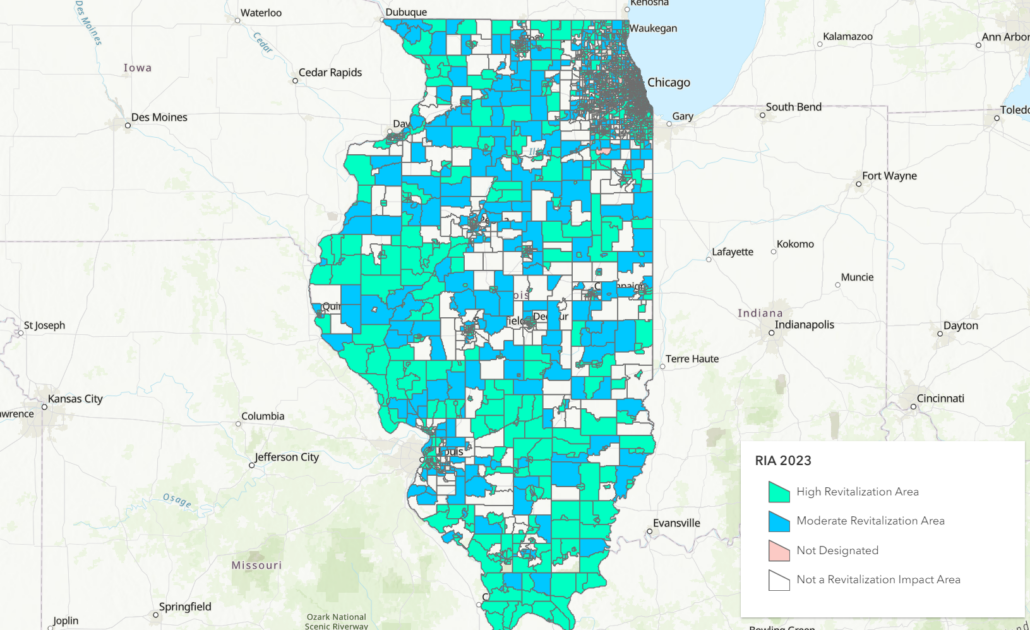Revitalization Impact Areas (RIA)
Revitalization Impact Areas (RIAs), as defined by IHDA, are targeted geographic areas that demonstrate the most salient market conditions suggesting that revitalization, or concerted community development planning, would be especially beneficial within these communities. RIAs identify census tracts demonstrating one or more of these market conditions, classifying them as either Moderate or High Revitalization Impact Areas.
Revitalization Impact Areas are incentivized under the Community Revitalization Scoring Criteria within the Low-Income Housing Tax Credit Program under “1) Addresses a pre-existing community need”. Points automatically awarded under this scoring category will be prorated based on the number of units falling within the census tract(s) for which the Revitalization Impact Area designation(s) applies for scattered-site projects falling within multiple census tracts.
Click on the map below to review Revitalization Impact Areas in Illinois.
Designation of Revitalization Impact Areas
Along with HUD designations, the market factors listed below, or revitalization indicators, are evaluated at the census tract-level in comparison to their corresponding set-aside averages and extremes (25th or 75th percentiles). The presence of an “extreme” rate in one or more of any of these factors as well as the presence of HUD designations determine whether census tracts demonstrate an opportunity for high or moderate revitalization impact.
- Poverty rate (family)
- Unemployment rate
- Median household income
- Housing vacancy rate
- Concentration of affordable housing units
Note that labor force participation rate was removed as a revitalization impact market factor in 2021. More information about this change can be found in the methodology document below. In addition to being incentivized under the Community Revitalization Scoring Criteria within the Low-Income Housing Tax Credit Program, the RIA provides free and accessible data for the public to utilize to understand various trends and needs throughout Illinois communities. The rates and figures of all market factors used to determine RIAs are available for every census tract within Illinois by using the interactive map above. Rates and figures can be viewed by searching for or clicking on census tracts.
IHDA believes that communities within or containing Moderate and High Revitalization Impact Areas may especially benefit from revitalization, or concerted community development planning. IHDA offers free technical assistance and planning services through its Community Revitalization Program. Individuals, local officials, and developers living or working in Moderate and High Revitalization Impact Areas are encouraged to learn more about and connect with the Community Revitalization Program.
Links/Resources
List of Revitalization Impact Areas by Census Tract
Contains a full listing of Revitalization Impact Areas by census tract throughout the state.
IHDA’s Strategic Planning and Reporting Department (SPAR) analyzes market characteristics within Illinois communities in a variety of capacities. These analyses, which include the Revitalization Impact Areas market tool, examine area’s assets, needs, and vulnerabilities, and help IHDA plan for impactful and successful investments. This document explains the full methodology of the RIA market tool.
2022-2023 Thresholds and Scoring Criteria
This document outlines the criteria for Community Revitalization Strategies under the Low-Income Housing Tax Credit Program, outlining the category’s Thresholds Requirements as well as Scoring Criteria for projects seeking points under the competitive 9% round.
Housing and Urban Development (HUD) and American Community Survey (ACS) 5-year estimates are used in the determination of this metric.
Revitalization Impact Areas shown on the map above and posted elsewhere on this site have been updated as of June 2021 utilizing the most current available data. IHDA will continue to update Revitalization Impact Areas on an annual basis or if there is a substantial change in the data sources used to calculate this metric.
The Illinois Housing Development Authority (“IHDA”) provides the data on this website as a service to the public. Although every effort has been made to provide complete and accurate information, IHDA makes no warranty, representation, or guaranty, express or implied, as to the content, accuracy, timeliness, or completeness of any of the data provided at this website. IHDA makes this data available on an “as is” basis and explicitly disclaims any representations and warranties, including, without limitation, the implied warranties of merchantability and fitness for a particular purpose. IHDA shall assume no liability for any errors, omissions, or inaccuracies in the data provided at this website regardless how caused or any decision made or action taken or not taken by anyone using or relying upon data provided at this website.


